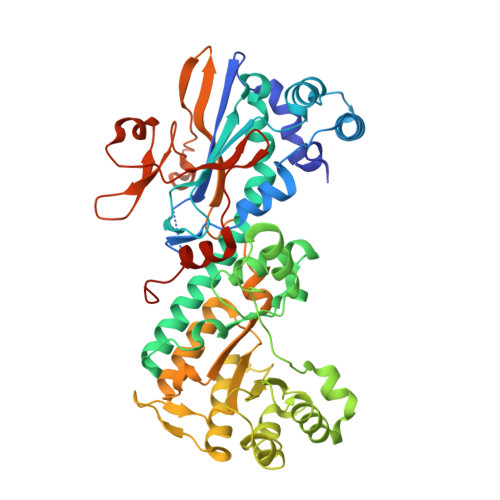Nicotinamide Phosphoribosyltransferase Positive Allosteric Modulators Attenuate Neuronal Oxidative Stress.
Gordon-Blake, J., Ratia, K., Weidig, V., Velma, G.R., Ackerman-Berrier, M., Penton, C., Musku, S.R., Alves, E.T.M., Driver, T., Tai, L., Thatcher, G.R.J.(2024) ACS Med Chem Lett 15: 205-214
- PubMed: 38352833
- DOI: https://doi.org/10.1021/acsmedchemlett.3c00391
- Primary Citation of Related Structures:
8TM7 - PubMed Abstract:
Evidence supports boosting nicotinamide adenine dinucleotide (NAD + ) to counteract oxidative stress in aging and neurodegenerative disease. One approach is to enhance the activity of nicotinamide phosphoribosyltransferase (NAMPT). Novel NAMPT positive allosteric modulators (N-PAMs) were identified. A cocrystal structure confirmed N-PAM binding to the NAMPT rear channel. Early hit-to-lead efforts led to a 1.88-fold maximum increase in the level of NAD + in human THP-1 cells. Select N-PAMs were assessed for mitigation of reactive oxygen species (ROS) in HT-22 neuronal cells subject to inflammatory stress using tumor necrosis factor alpha (TNFα). N-PAMs that increased NAD + more effectively in THP-1 cells attenuated TNFα-induced ROS more effectively in HT-22 cells. The most efficacious N-PAM completely attenuated ROS elevation in glutamate-stressed HT-22 cells, a model of neuronal excitotoxicity. This work demonstrates for the first time that N-PAMs are capable of mitigating elevated ROS in neurons stressed with TNFα and glutamate and provides support for further N-PAM optimization for treatment of neurodegenerative diseases.
Organizational Affiliation:
Department of Pharmaceutical Sciences, Research Resources Center, Department of Chemistry, and Department of Anatomy and Cell Biology, University of Illinois at Chicago, Chicago, Illinois 60612, United States.



















